The mDOT Center
Transforming health and wellness via temporally-precise mHealth interventions






mDOT@MD2K.org
901.678.1526
901.678.1526








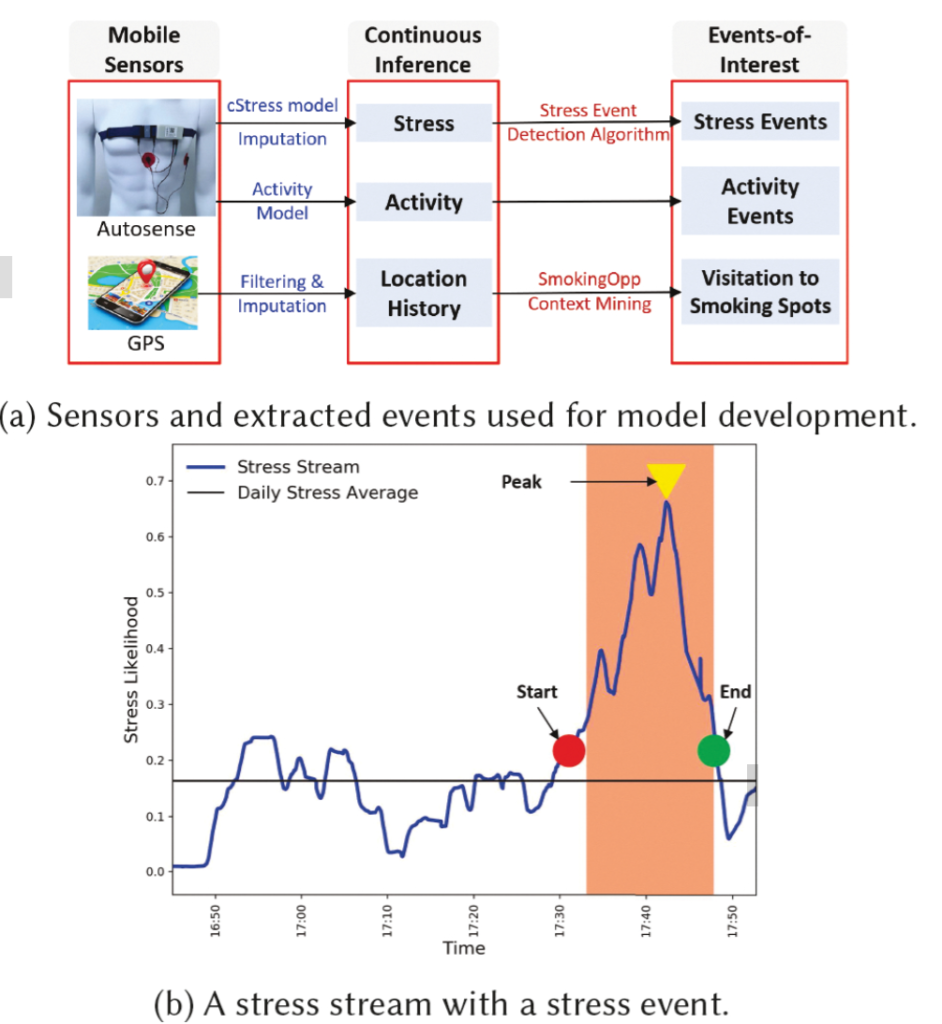
ACM on Interactive, Mobile, Wearable, and Ubiquitous Technologies (IMWUT)
September 7, 2022
behavioral intervention, human-centered computing, risk prediction, smoking cessation, ubiquitous and mobile computing design and evaluation methods, wearable sensors
Passive detection of risk factors (that may influence unhealthy or adverse behaviors) via wearable and mobile sensors has created new opportunities to improve the effectiveness of behavioral interventions. A key goal is to find opportune moments for intervention by passively detecting rising risk of an imminent adverse behavior. But, it has been difficult due to substantial noise in the data collected by sensors in the natural environment and a lack of reliable label assignment of low- and high-risk states to the continuous stream of sensor data. In this paper, we propose an event-based encoding of sensor data to reduce the effect of noises and then present an approach to efficiently model the historical influence of recent and past sensor-derived contexts on the likelihood of an adverse behavior. Next, to circumvent the lack of any confirmed negative labels (i.e., time periods with no high-risk moment), and only a few positive labels (i.e., detected adverse behavior), we propose a new loss function. We use 1,012 days of sensor and self-report data collected from 92 participants in a smoking cessation field study to train deep learning models to produce a continuous risk estimate for the likelihood of an impending smoking lapse. The risk dynamics produced by the model show that risk peaks an average of 44 minutes before a lapse. Simulations on field study data show that using our model can create intervention opportunities for 85% of lapses with 5.5 interventions per day.
We present a model for identifying ideal moments for intervention by passively detecting risk of an imminent adverse behavior.
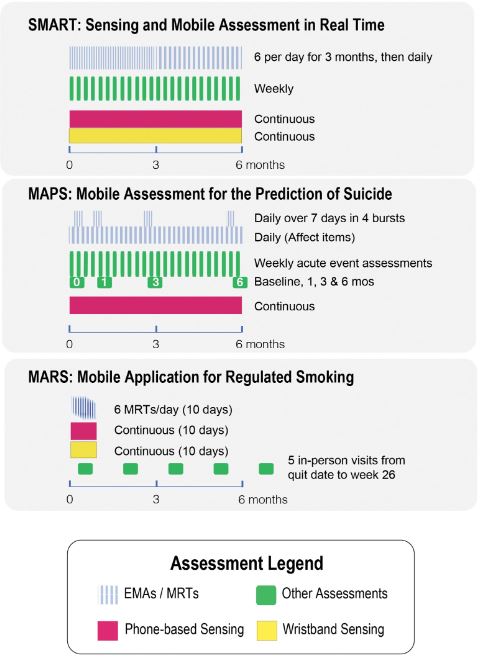
Sy-Miin Chow, Inbal Nahum-Shani, Justin Baker, Donna Spruijt-Metz, Nicholas Allen, Randy Auerbach, Genevieve Dunton, Naomi Friedman, Stephen Intille, Predrag Klasnja, Benjamin Marlin, Matthew Nock, Scott Rauch, Misha Pavel, Scott Vrieze, David Wetter, Evan Kleiman, Timothy Brick, Heather Perry, Dana Wolff-Hughes
Translational Behavioral Medicine, Volume 13, Issue 1, January 2023, Pages 7–16
November 23, 2022
EMA, health behavior changes, ILHBN, location, sensor
The ILHBN is funded by the National Institutes of Health to collaboratively study the interactive dynamics of behavior, health, and the environment using Intensive Longitudinal Data (ILD) to (a) understand and intervene on behavior and health and (b) develop new analytic methods to innovate behavioral theories and interventions. The heterogenous study designs, populations, and measurement protocols adopted by the seven studies within the ILHBN created practical challenges, but also unprecedented opportunities to capitalize on data harmonization to provide comparable views of data from different studies, enhance the quality and utility of expensive and hard-won ILD, and amplify scientific yield. The purpose of this article is to provide a brief report of the challenges, opportunities, and solutions from some of the ILHBN’s cross-study data harmonization efforts. We review the process through which harmonization challenges and opportunities motivated the development of tools and collection of metadata within the ILHBN. A variety of strategies have been adopted within the ILHBN to facilitate harmonization of ecological momentary assessment, location, accelerometer, and participant engagement data while preserving theory-driven heterogeneity and data privacy considerations. Several tools have been developed by the ILHBN to resolve challenges in integrating ILD across multiple data streams and time scales both within and across studies. Harmonization of distinct longitudinal measures, measurement tools, and sampling rates across studies is challenging, but also opens up new opportunities to address cross-cutting scientific themes of interest.
The article shares insights, challenges, opportunities, and solutions from harmonizing intensive longitudinal data within the ILHBN, providing tools and recommendations for future data harmonization efforts.

Addictive Behaviors, Volume 136, p.107467
January 2023
just-in-time adaptive intervention, micro-randomized trial, mindfulness; smoking cessation; mHealth
Smoking cessation treatments that are easily accessible and deliver intervention content at vulnerable moments (e.g., high negative affect) have great potential to impact tobacco abstinence. The current study examined the feasibility and acceptability of a multi-component Just-In-Time Adaptive Intervention (JITAI) for smoking cessation. Daily smokers interested in quitting were consented to participate in a 6-week cessation study. Visit 1 occurred 4 days pre-quit, Visit 2 was on the quit day, Visit 3 occurred 3 days post-quit, Visit 4 was 10 days post-quit, and Visit 5 was 28 days post-quit. During the first 2 weeks (Visits 1-4), the JITAI delivered brief mindfulness/motivational strategies via smartphone in real-time based on negative affect or smoking behavior detected by wearable sensors. Participants also attended 5 in-person visits, where brief cessation counseling (Visits 1-4) and nicotine replacement therapy (Visits 2-5) were provided. Outcomes were feasibility and acceptability; biochemically-confirmed abstinence was also measured. Participants (N = 43) were 58.1 % female (AgeMean = 49.1, mean cigarettes per day = 15.4). Retention through follow-up was high (83.7 %). For participants with available data (n = 38), 24 (63 %) met the benchmark for sensor wearing, among whom 16 (67 %) completed at least 60 % of strategies. Perceived ease of wearing sensors (Mean = 5.1 out of 6) and treatment satisfaction (Mean = 3.6 out of 4) were high. Biochemically-confirmed abstinence was 34 % at Visit 4 and 21 % at Visit 5. Overall, the feasibility of this novel multi-component intervention for smoking cessation was mixed but acceptability was high. Future studies with improved technology will decrease participant burden and better detect key intervention moments.
The study assessed the feasibility and acceptability of a multi-component Just-In-Time Adaptive Intervention (JITAI) for smoking cessation, utilizing smartphone-delivered mindfulness/motivational strategies based on real-time negative affect or smoking behavior detected by wearable sensors. Participants showed high retention (83.7%) and reported high satisfaction with the intervention, but the feasibility was mixed.
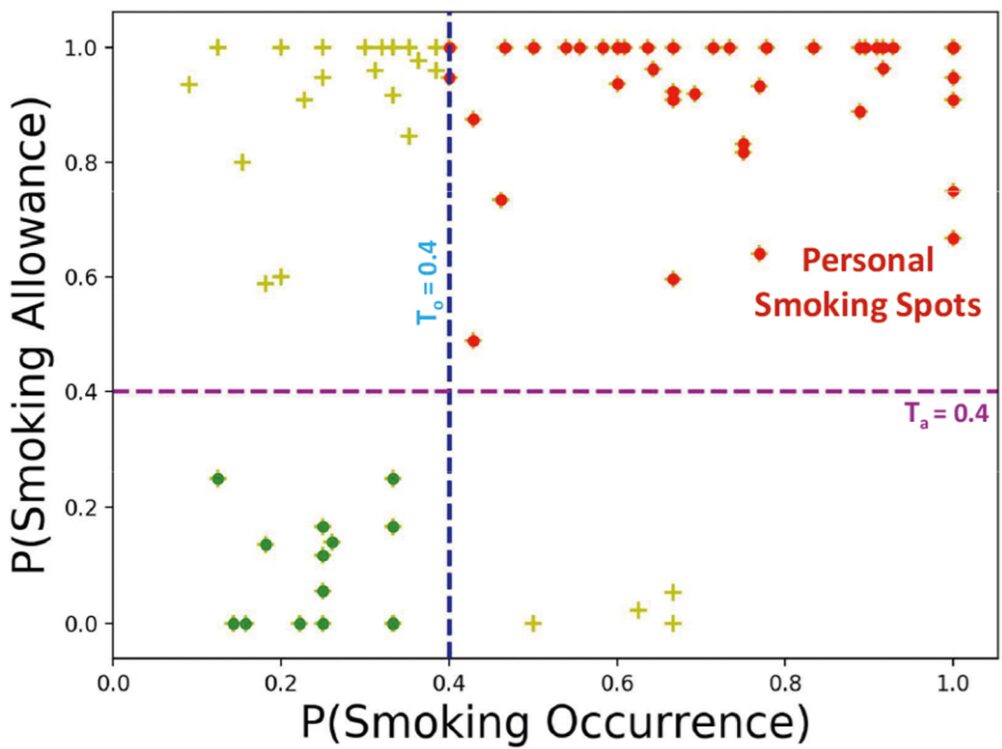
Proceedings of the ACM on Interactive, Mobile, Wearable and Ubiquitous Technologies
mobile health, context, smoking cessation, intervention, GPS traces
March 2020
Context plays a key role in impulsive adverse behaviors such as fights, suicide attempts, binge-drinking, and smoking lapse. Several contexts dissuade such behaviors, but some may trigger adverse impulsive behaviors. We define these latter contexts as ‘opportunity’ contexts, as their passive detection from sensors can be used to deliver context-sensitive interventions. In this paper, we define the general concept of ‘opportunity’ contexts and apply it to the case of smoking cessation. We operationalize the smoking ‘opportunity’ context, using self-reported smoking allowance and cigarette availability. We show its clinical utility by establishing its association with smoking occurrences using Granger causality. Next, we mine several informative features from GPS traces, including the novel location context of smoking spots, to develop the SmokingOpp model for automatically detecting the smoking ‘opportunity’ context. Finally, we train and evaluate the SmokingOpp model using 15 million GPS points and 3,432 self-reports from 90 newly abstinent smokers in a smoking cessation study.
In this paper, we define the general concept of ‘opportunity’ contexts and apply it to the case of smoking cessation. We mine several informative features from GPS traces, including the novel location context of smoking spots, to develop the SmokingOpp model for automatically detecting the smoking ‘opportunity’ context.
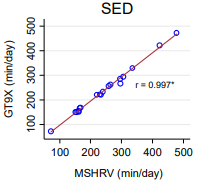
Sensors (Basel)
MotionSense HRV, accelerometer, mobile health, physical activity, sedentary behavior
February 18, 2021
MotionSense HRV is a wrist-worn accelerometery-based sensor that is paired with a smartphone and is thus capable of measuring the intensity, duration, and frequency of physical activity (PA). However, little information is available on the validity of the MotionSense HRV. Therefore, the purpose of this study was to assess the concurrent validity of the MotionSense HRV in estimating sedentary behavior (SED) and PA. A total of 20 healthy adults (age: 32.5 ± 15.1 years) wore the MotionSense HRV and ActiGraph GT9X accelerometer (GT9X) on their non-dominant wrist for seven consecutive days during free-living conditions. Raw acceleration data from the devices were summarized into average time (min/day) spent in SED and moderate-to-vigorous PA (MVPA). Additionally, using the Cosemed K5 indirect calorimetry system (K5) as a criterion measure, the validity of the MotionSense HRV was examined in simulated free-living conditions. Pearson correlations, mean absolute percent errors (MAPE), Bland-Altman (BA) plots, and equivalence tests were used to examine the validity of the MotionSense HRV against criterion measures. The correlations between the MotionSense HRV and GT9X were high and the MAPE were low for both the SED (r = 0.99, MAPE = 2.4%) and MVPA (r = 0.97, MAPE = 9.1%) estimates under free-living conditions. BA plots illustrated that there was no systematic bias between the MotionSense HRV and criterion measures. The estimates of SED and MVPA from the MotionSense HRV were significantly equivalent to those from the GT9X; the equivalence zones were set at 16.5% for SED and 29% for MVPA. The estimates of SED and PA from the MotionSense HRV were less comparable when compared with those from the K5. The MotionSense HRV yielded comparable estimates for SED and PA when compared with the GT9X accelerometer under free-living conditions. We confirmed the promising application of the MotionSense HRV for monitoring PA patterns for practical and research purposes.
The purpose of this study was to assess the concurrent validity of the MotionSense HRV in estimating sedentary behavior (SED) and PA.
CP5 is recruiting daily smokers interested in quitting who wear the AutoSense chestband and MotionSense wrist sensors for one week prior to quitting and two weeks post-quit. They also carry a study-provided smartphone. From the sensor data, CP5 is obtaining sensor-derived biomarkers of stress, geoexposure, and smoking, and EMA’s provide additional assessment of emotions and context. CP5 will work with Aims 1, 2, and 3 of TR&D1. An initial model for SRC under development by CP5 does not explicitly account for uncertainty in sensor-derived biomarkers or in EMA-based assessments resulting from missingness. A push activity will utilize uncertainty models developed in Aim 1 of TR&D1 to represent and quantify uncertainty in sensor- and EMA-derived biomarkers. In a pull activity, we will jointly characterize the resulting uncertainty in the model for SRC. This will enable researchers to take measurement of uncertainty into account when analyzing the linkage between SRC and distinct emotions, EMA-derived context, sensor-derived states of stress and craving, and geographic context. In addition, uncertainty representation for the derived SRC biomarker can inform downstream analysis of the link between SRC and lapse risk. CP5 will work with TR&D1 Aim 2 to identify timing triggers from affect, context, SRC, and other lapse risks from the collected data, to guide the delivery of temporally-precise interventions. CP5 will utilize tools developed in Aim 2 for identifying specific temporal patterns that predict future lapse risk. Analysis of the effectiveness of these triggers on collected data will lead to a pull activity in which the identified temporal patterns are distilled into a composite risk score which can be computed from sensor data in real-time and characterizes the time-varying risk level. The resulting time triggers and risk scores will be utilized in the MRT which will be deployed by CP1. CP5 will utilize methods from TR&D1 Aim 3 for modeling the dynamic relationships between positive and negative discrete emotions, and biomarkers for stress, craving, and context that inform the temporal variations in SRC and lapse risk. Initially, the models will describe the lead-lag relationships between covariates. When sufficient sensor data has been collected, a pull activity with Aim 3 of TR&D1 will jointly develop deep feature learning methods based on variational autoencoders that can learn nonlinear temporal features to improve the accuracy in predicting the time-varying risk of lapse. This can help discover the optimal content and timing for temporally-precise interventions. The iterations between the two teams in testing the initial model, revising the model, and testing again will eventually lead to methods for all three aims that will be directly applicable to smoking cessation research using mHealth biomarkers.
You must be logged in to post a comment.
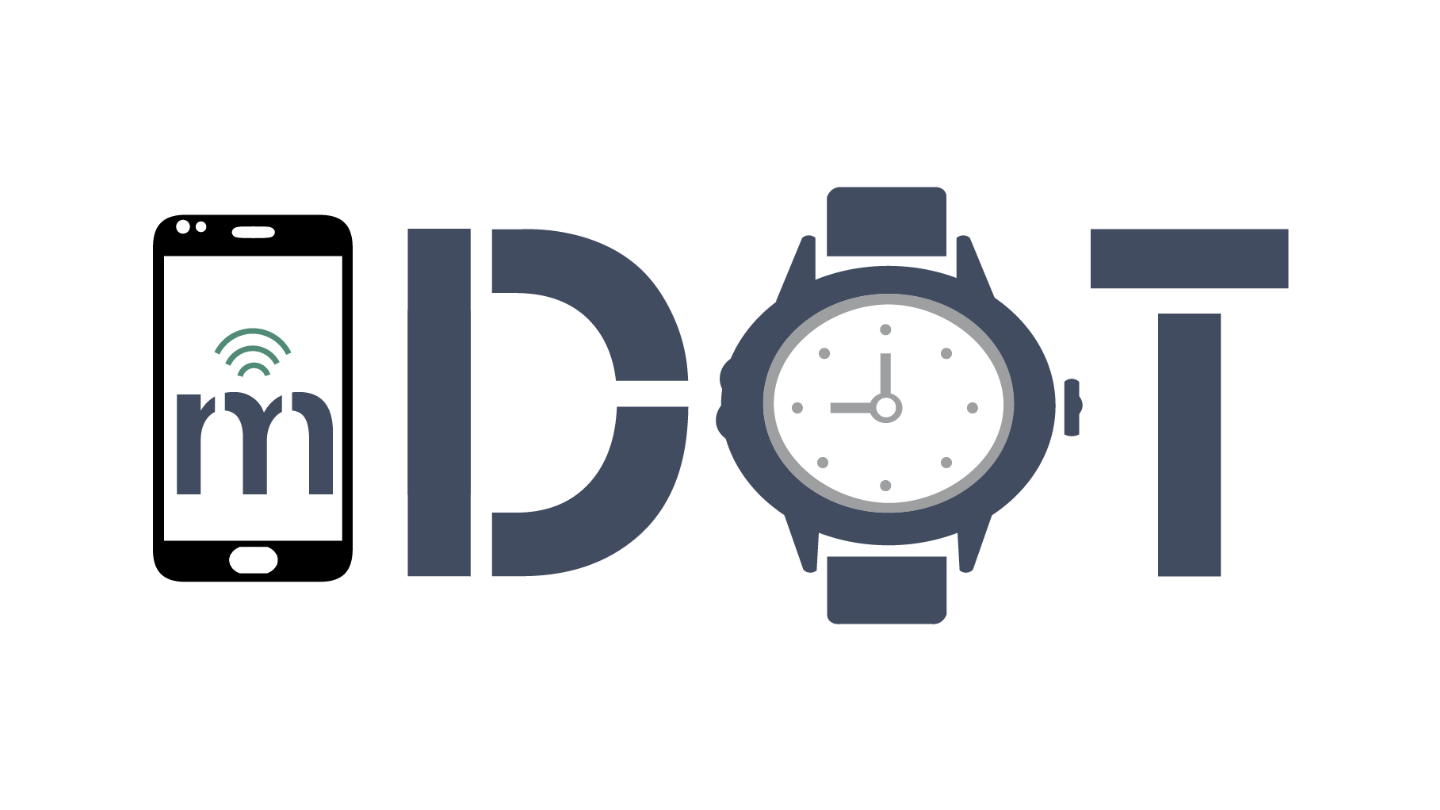
No Comments